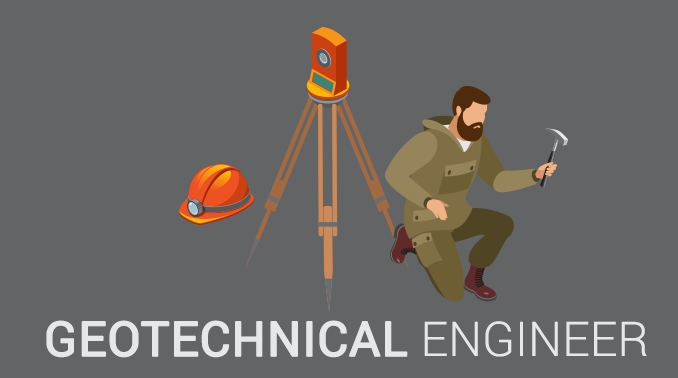Little Known Questions About Geotheta.
Little Known Questions About Geotheta.
Blog Article
The 30-Second Trick For Geotheta
Table of ContentsSome Known Factual Statements About Geotheta All about GeothetaThe Only Guide for Geotheta9 Simple Techniques For GeothetaThe 5-Minute Rule for Geotheta

They conduct site examinations, gather samples, perform lab tests, and analyze data to assess the viability of the ground for building and construction jobs - Geotechnical Engineers. Based on their searchings for, geotechnical engineers offer referrals for foundation style, incline stability, maintaining frameworks, and mitigation of geotechnical hazards. They collaborate with other professionals, such as architects, structural designers, and construction teams, to make sure that geotechnical factors to consider are integrated right into the total project design and application
By assessing the behavior and residential or commercial properties of dirt and rock, they can identify possible geotechnical risks such as landslides, soil negotiation, or slope instability. Their know-how aids prevent failings or accidents that could threaten lives and residential property. Right here are some thorough obligations and obligations of a geotechnical engineer: Website Examination: Geotechnical designers conduct website investigations to collect data on subsurface problems.
They interpret the data to understand the residential properties and behavior of the dirt and rock, including their toughness, permeability, compaction features, and groundwater problems. Geotechnical Analysis and Design: Geotechnical engineers examine the information gathered throughout site investigations to evaluate the security and viability of the website for building and construction jobs. They carry out geotechnical computations and modeling to review aspects such as birthing capacity, settlement, slope security, lateral planet pressures, and groundwater circulation.
The Best Strategy To Use For Geotheta
Structure Layout: Geotechnical designers play a crucial duty in designing structures that can safely support the intended framework. They examine the soil problems and load demands to establish the suitable structure type, such as superficial foundations (e.g., footings), deep foundations (e.g (https://justpaste.it/ec966)., stacks), or specialized strategies like soil improvement. They consider elements such as settlement restrictions, birthing capacity, and soil-structure communication to develop optimum foundation layouts
They examine building plans, monitor website tasks, and conduct area evaluations to validate that the style recommendations are adhered to. If unforeseen geotechnical concerns develop, they analyze the situation and provide referrals for remediation or modifications to the style. Threat Evaluation and Reduction: Geotechnical designers examine geotechnical threats and dangers related to the project site, such as landslides, liquefaction, or soil erosion.

Partnership and Communication: Geotechnical engineers function carefully with other professionals included in a task, such as engineers, architectural engineers, and building groups. Efficient interaction and collaboration are necessary to incorporate geotechnical factors to consider right into the general job layout and building process. Geotechnical engineers provide technical knowledge, answer questions, and make certain that geotechnical demands are met.
Not known Facts About Geotheta
Right here are some kinds of geotechnical designers: Structure Designer: Foundation engineers go to this site specialize in developing and examining foundations for frameworks. They assess the dirt conditions, lots needs, and site characteristics to identify one of the most appropriate foundation type and layout, such as superficial structures, deep foundations, or specialized strategies like pile structures.
They review the variables affecting incline stability, such as dirt homes, groundwater conditions, and incline geometry, and establish techniques to stop slope failures and minimize threats. Quake Designer: Earthquake engineers specialize in examining and developing structures to withstand seismic pressures. They examine the seismic risk of a site, evaluate dirt liquefaction capacity, and create seismic style requirements to guarantee the safety and strength of structures throughout earthquakes.
They do field testing, collect samples, and examine the collected data to identify the soil properties, geologic developments, and groundwater conditions at a website. Geotechnical Instrumentation Designer: Geotechnical instrumentation designers concentrate on tracking and measuring the behavior of dirt, rock, and structures. They install and preserve instrumentation systems that monitor aspects such as dirt negotiation, groundwater degrees, incline motions, and structural variations to examine efficiency and supply early cautions of possible issues.
The Buzz on Geotheta
They conduct tests such as triaxial tests, consolidation tests, direct shear tests, and permeability examinations to gather information for geotechnical evaluation and design. Geosynthetics Engineer: Geosynthetics designers concentrate on the design and application of geosynthetic materials, such as geotextiles, geogrids, and geomembranes. They use these products to enhance dirt security, enhance inclines, offer drain solutions, and control disintegration.
They often tend to be investigative people, which suggests they're intellectual, reflective, and investigative. They are curious, systematic, sensible, logical, and rational. Some of them are also social, suggesting they're kind, charitable, participating, individual, caring, useful, compassionate, tactful, and pleasant - Engineer of Record.
In the workplace environment, geotechnical designers make use of specialized software application devices to execute estimations, produce designs, and examine data. They prepare records, evaluation project requirements, communicate with customers and team members, and coordinate task tasks. The office setting provides a helpful environment for study, analysis, and partnership with other specialists included in the project.
Fascination About Geotheta
They regularly go to job websites to conduct site examinations, examine geotechnical conditions, and gather data for analysis. These visits include taking a trip to various areas, in some cases in remote or difficult surfaces. Geotechnical designers may execute dirt sampling, conduct examinations, and monitor construction activities to make certain that the geotechnical elements of the task are being carried out properly.
Geotechnical engineers also work in specialized geotechnical labs. In these facilities, they carry out experiments, carry out tests on dirt and rock samples, and assess the engineering buildings of the products. Geotechnical laboratory engineers function thoroughly in these settings, taking care of screening tools, running tools, and recording data. They collaborate with other laboratory staff to guarantee accurate and reputable testing outcomes.
Report this page